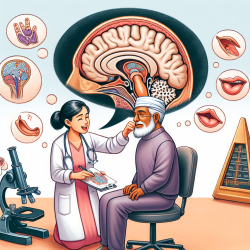Speech therapists are continually seeking ways to refine their practice and improve outcomes for their clients. One area of research that holds promising insights for therapeutic strategies is the study of speech characteristics in individuals with Friedreich's Ataxia (FA). This neurological disorder, while rare, provides a unique window into the complexities of speech production and the cerebellum's role in articulation and timing. By understanding the characteristics of diadochokinesis (DDK) of oropharyngeal and limb movements in Friedreich's Ataxia, therapists can enhance their approach to speech therapy.
Understanding Friedreich's Ataxia and Its Impact on Speech
Friedreich's Ataxia is a genetic, progressive, neurodegenerative disorder that affects the nervous system and the heart. It's characterized by ataxia of gait and limbs, dysarthria (a motor speech disorder), and a range of other neurological signs. The speech of individuals with FA often exhibits a slow rate, irregular rhythm, and changes in voice quality, among other features. These speech characteristics stem from the disorder's impact on the cerebellum and its connections, which play a crucial role in coordinating movement, including speech articulation.
Diadochokinesis in Friedreich's Ataxia
Diadochokinesis, or the ability to make rapid, alternating movements, is often impaired in individuals with FA. This impairment affects both limb movements and speech articulation. Research has shown that the DDK rates for speech articulators (e.g., lips, jaw, tongue) and limbs are significantly slower in individuals with FA compared to control groups. These findings highlight the cerebellum's role in the temporal coordination of speech and suggest that similar mechanisms may underlie both speech and limb DDK rates.
Implications for Speech Therapy
The insights gained from studying speech characteristics in FA can inform therapeutic strategies in several ways:
- Targeted Exercises: Understanding the specific challenges in DDK rates can lead therapists to design targeted exercises that focus on improving the speed and coordination of speech movements.
- Comprehensive Assessment: Therapists can incorporate assessments of DDK rates for both speech and limb movements into their evaluations, providing a more comprehensive understanding of a client's motor abilities.
- Technology Integration: Advances in technology can aid in the precise measurement of DDK rates and the development of computer-assisted therapy programs tailored to improving articulatory coordination.
- Interdisciplinary Collaboration: The overlap between speech and limb motor control underscores the importance of interdisciplinary collaboration, particularly with physical and occupational therapists, to address the multifaceted needs of individuals with motor disorders.
Encouraging Further Research and Application
While the research on FA offers valuable insights, it also highlights the need for further investigation into the underlying mechanisms of speech production and motor control. Speech therapists are encouraged to engage with this research actively, whether by applying its findings in clinical practice or contributing to the growing body of knowledge through their observations and experiences.
In conclusion, the study of Friedreich's Ataxia and its impact on speech provides important implications for speech therapy. By leveraging these insights, therapists can enhance their therapeutic strategies, ultimately improving the speech and communication abilities of individuals with FA and related disorders. For those interested in exploring this topic further, the original research paper provides a detailed analysis of diadochokinesis in Friedreich's Ataxia and can be accessed Caractéristiques de la diadococinésie des valves phonoarticulatoires et des extrémités dans l'ataxie de Friedreich.










